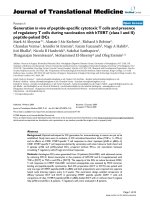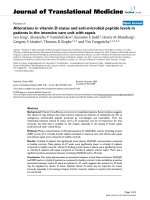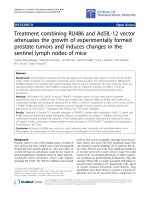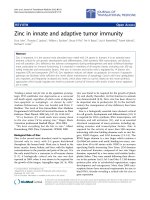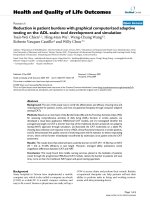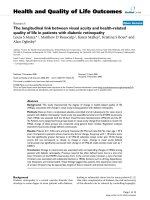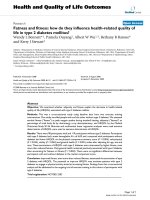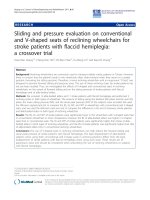báo cáo hóa học: " Changes in spatiotemporal gait variables over time during a test of functional capacity after stroke" pot
Bạn đang xem bản rút gọn của tài liệu. Xem và tải ngay bản đầy đủ của tài liệu tại đây (219.77 KB, 7 trang )
BioMed Central
Page 1 of 7
(page number not for citation purposes)
Journal of NeuroEngineering and
Rehabilitation
Open Access
Research
Changes in spatiotemporal gait variables over time during a test of
functional capacity after stroke
Kathryn M Sibley
1,2,4
, Ada Tang
1,2,4
, Kara K Patterson
3,4
, Dina Brooks
1,2,3,4
and William E McIlroy*
1,3,4,5
Address:
1
Institute of Medical Science, University of Toronto, Toronto, Canada,
2
Department of Physical Therapy, University of Toronto, Toronto,
Canada,
3
Graduate Department of Rehabilitation Science, University of Toronto, Toronto, Canada,
4
Toronto Rehabilitation Institute, Toronto,
Canada and
5
Department of Kinesiology, University of Waterloo, Waterloo, Canada
Email: Kathryn M Sibley - ; Ada Tang - ; Kara K Patterson - ;
Dina Brooks - ; William E McIlroy* -
* Corresponding author
Abstract
Background: Gait dysfunction and fatigue are common post-stroke, though it is unclear how
extended walking activity, as would be performed during activities of daily living, may change over
time. The purpose of this study was to examine if spatial and temporal gait variables deteriorate
during an extended bout of walking in a test of functional capacity after stroke.
Methods: 24 community dwelling, independently ambulating individuals greater than 3 months
after stroke performed the Six-Minute Walk Test (6MWT). Participants walked over a pressure-
sensitive mat on each pass of the 30 m course which recorded spatial and temporal parameters of
gait. Mean gait speed and temporal symmetry ratio during each two-minute interval of the 6MWT
were examined. Additional post hoc analyses examined the incidence of rests during the 6MWT
and changes in gait speed and symmetry.
Results: On average, participants demonstrated a 3.4 ± 6.5 cm/s decrease in speed over time (p=
0.02). Participants who rested were also characterized by increased asymmetry in the final two
minutes (p= 0.05). 30% of participants rested at some point during the test, and if a rest was taken,
duration increased in the final two minutes (p= 0.001). Examination of factors which may have been
associated with resting indicated that resters had poorer balance (p= 0.006) than non-resting
participants.
Conclusion: This study supports previous findings establishing that walking performance after
stroke declines over relatively short bouts of functionally-relevant ambulation. Such changes may
be associated with both cardiorespiratory and muscular fatigue mechanisms that influence
performance. The findings also indicate that rest duration should be routinely quantified during the
6MWT after stroke, and consequently, further research is necessary to determine how to interpret
6MWT scores when resting occurs.
Published: 14 July 2009
Journal of NeuroEngineering and Rehabilitation 2009, 6:27 doi:10.1186/1743-0003-6-27
Received: 26 May 2008
Accepted: 14 July 2009
This article is available from: />© 2009 Sibley et al; licensee BioMed Central Ltd.
This is an Open Access article distributed under the terms of the Creative Commons Attribution License ( />),
which permits unrestricted use, distribution, and reproduction in any medium, provided the original work is properly cited.
Journal of NeuroEngineering and Rehabilitation 2009, 6:27 />Page 2 of 7
(page number not for citation purposes)
Background
Sensorimotor control is commonly impaired following
stroke, and such changes in strength and coordination can
significantly affect gait [1]. Gait impairments influence
functional ambulation – the capacity to perform walking
during activities of daily living – and are compounded by
low cardiorespiratory fitness in stroke survivors [2,3]. Fur-
thermore, fatigue is a commonly reported issue after
stroke [4,5], and cardiorespiratory and muscular compo-
nents of fatigue may mutually reinforce one another. For
example, both cardiorespiratory deconditioning and fibre
type changes may exacerbate underlying physiological
sensorimotor impairments, and ultimately compromise
the functional performance of activities of daily living – in
particular that of gait.
Congruent with evidence for increased fatigue and
impaired gait after stroke, previous studies have demon-
strated that walking speed in individuals with stroke can
decrease in as little as six minutes of continuous effortful
walking. Sibley et al. [6] reported that individuals in the
sub-acute phase (< 3 months) after stroke covered less dis-
tance in the latter phases of the Six-Minute Walk Test
(6MWT), a test of functional ambulation, compared to
the initial two minutes of the test. Eng et al. [7] reported
similar changes of smaller magnitude in participants in
the chronic stroke phase (> 3 months) who walked even
shorter distances overall. The above authors hypothesized
that the changes in walking speed reflected the impact of
cardiorespiratory challenge and fatigue; however, it was
not possible in either of those studies to determine if sen-
sorimotor control worsened over time and contributed to
the decreased performance.
Sensorimotor control of gait may be examined through
the assessment of both spatial and temporal parameters.
Post-stroke reductions in gait speed [1] are well-estab-
lished and provide a summary measure of the overall state
of walking function. Additional indices such as the tem-
poral symmetry ratio between paretic and non-paretic
limbs can also offer further insight regarding the nature of
sensorimotor impairment. Walking in healthy individuals
is characterized by a symmetrical pattern between limbs,
unlike post-stroke gait which is often asymmetric in tim-
ing and favors the paretic limb [8,9]. Of importance to the
present study is the idea that activity-induced fatigue may
influence both of these measures via cardiorespiratory
(influences on speed) and peripheral muscle changes
(influences on asymmetry). We hypothesize that
extended periods of walking (as simulated by the 6MWT)
exacerbate gait dyscontrol in individuals with stroke, and
are likely linked to the associated mechanisms of fatigue.
Accordingly, the purpose of the present study was to
examine changes in spatial and temporal gait parameters
during an extended, effortful period of walking in individ-
uals after stroke. We hypothesized that participants would
demonstrate a progressive slowing of gait speed over the
period of the test and an increased expression of gait dys-
control, as reflected by increased temporal asymmetry.
This work extends understanding of sensorimotor impair-
ment after stroke by examining gait characteristics under
the challenges that may be typical of community living
(six minutes of walking) rather than very short distances
(e.g. 5–10 m). This work can also provide insight into
both the determinants and interpretation of indices of
functional walking (such as the 6MWT) as it is applied to
individuals who have had a stroke.
Methods
This study was conducted within a larger trial on the
application of a cardiac rehabilitation model post stroke.
Local university and hospital research ethics committees
approved the study and all participants provided
informed written consent.
Participants
Twenty-four community dwelling stroke survivors
enrolled. Inclusion criteria were: ability to provide
informed consent, understand the evaluation procedures,
greater than three months post-stroke, have a Chedoke-
McMaster Stroke Assessment (CMSA) leg impairment
score greater than 2 (where voluntary movement is
present without facilitation [10]), and as part of the larger
trial, be able to walk at least five meters independently.
Participants were excluded if they exhibited any contrain-
dications to maximal exercise testing as outlined by the
American College of Sports Medicine (ACSM) [11] or
musculoskeletal impairments or pain which would limit
the ability to perform the tests.
Protocol
Participants performed the 6MWT according to standard-
ized instructions [12]. Participants were instructed to walk
as far as possible for a period of six minutes. Participants
walked back and forth over a 30-meter course and per-
formed a 180° turn at each end. They were permitted to
use their walking aids and rest by standing in one loca-
tion, leaning on a wall or sitting as needed. No encourage-
ment was provided during the test. As part of the larger
study, all participants had completed the test at least once
before to reduce potential learning effects on 6MWT per-
formance.
As part of the larger study, participants also completed
clinical measures of stroke severity (National Institutes of
Health (NIH) Stroke Scale) and sensorimotor recovery
(CMSA), a maximal exercise test on a semi-recumbent
cycle ergometer, a clinical balance assessment (Berg Bal-
ance Scale (BBS) [13]), and a gait assessment at preferred
Journal of NeuroEngineering and Rehabilitation 2009, 6:27 />Page 3 of 7
(page number not for citation purposes)
and fast paces. Details of the methods of these assess-
ments are published elsewhere [3,6].
Outcome Measures
Distance walked, rest frequency and rest duration were
assessed for each two-minute interval of the 6MWT and
for the entire test. Heart Rate (HR) and rating of perceived
exertion (RPE, 0 – 10 scale) [14] were collected at the
beginning and end of the test.
A 5 m long pressure sensitive mat was placed in the mid-
dle of the course to measure spatial and temporal gait
parameters. Participants walked over the mat on each pass
of the 30 m course. Gait speed and temporal symmetry
ratio were averaged for each two minute interval. Tempo-
ral symmetry ratio was determined by calculating the ratio
of swing time/stance time for each limb, and then divid-
ing the limb with the larger ratio by the limb with the
smaller ratio [9]. While most individuals with post-stroke
asymmetry are characterized by greater stance times on
the non-paretic limb, a small number of individuals
appear to increase the stance time on the paretic as
opposed to the non-paretic limb. As a result, it is necessary
to generate an absolute ratio of symmetry with perfect
symmetry equaling a ratio of 1.0 and any asymmetry
increasing from 1.0, irrespective to the direction of the
asymmetry.
Peak oxygen uptake (VO
2
peak), preferred gait speed and
symmetry ratio, BBS, NIH, CMSA scores were extracted
from the assessments completed for the larger study.
Analysis
A one-factor, within-subjects ANOVA evaluated differ-
ences in walking distance, rest duration, gait speed and
symmetry ratio between the three intervals of the 6MWT.
Post hoc Tukey's tests were conducted where significant
differences were observed. Preliminary analyses examin-
ing step variability measures did not show any significant
changes over time. Additional analysis of patient sub-
groups, comparing those who rested (REST) versus those
who did not (NO REST), consisted of a two-factor ANOVA
for continuous variables, chi-square tests for categorical
variables and Wilcoxon-Mann-Witney test for non-para-
metric variables. Statistical significance was set at p < 0.05.
Values expressed are mean ± standard deviation.
Results
Clinical characteristics are presented in Table 1. Mean
total distance walked was 283.3 ± 136.8 m (range 78 –
552 m). The mean increase in heart rate was 21.3 ± 14.0
beats/min (range 5 – 56 beats/min), which represented
86.8 ± 3.9% (range 49 – 115%) of peak heart rate at the
end of the test and the median reported RPE score was 3
(range 1 – 10). Performance across time is illustrated in
Table 2. There was a significant decrease in distance
walked over time during the 6MWT [F(2, 22) = 4.3, p =
0.02]. On average, participants walked 6.4 ± 18.1 m less
in the second two minutes relative to the initial two min-
utes, and a further 5.4 ± 17.1 m less in the final two min-
utes (relative to the middle two minutes). Post hoc Tukey
analysis indicated that the distance walked in the final two
minutes was significantly lower than that walked in the
first two minutes. Spatiotemporal data for one subject was
excluded due to a shuffling gait pattern which could not
be analyzed by the software. There was a significant
change in gait speed over time throughout the 6MWT
[F(2, 22) = 4.5, p = 0.02]. This statistical difference was
due to a 4.0 ± 10% decrease in speed from the first to last
Table 1: Clinical characteristics.
Entire cohort (n = 24) Rest group (n = 7) No Rest Group (n = 17) Between-group p value
Age (years) 63 ± 13 (38 – 86) 68 ± 15 (38 – 86) 61 ± 12 (41 – 83) 0.26
Gender (M/F) 17/7 14/3 4/3 0.4
Time post stroke (months) 38 ± 26 (12 – 121) 43 ± 38 (12 – 121) 37 ± 21 (16 – 92) 0.6
Stroke type
(infarct/hemorrhage/unknown)
14/8/2 5/2/0 9/6/2 0.6
Body side affected
(left/right/bilateral)
11/12/1 4/3/0 7/9/1 0.7
CMSA leg 5 ± 1 (2 – 7) 5 ± 1 (2 – 6) 5 ± 1 (3 – 7) 0.8
NIH 4 ± 2 (0 – 9) 4 ± 1 (3 – 7) /4 ± 2 (0 – 9) 0.6
Gait aid (aid/no aid) 13/11 5/2 8/9 0.3
VO
2
peak (ml/kg-min) 14.9 ± 4.6 (8.0 – 24.5) 12.5 ± 5.3 (8 – 22.5) 16.1 ± 4.0 (27.8 – 129.7) 0.1
HRpeak (beats/min) 113.3 ± 4.5 (80.0 – 148.0) 115.9 ± 5.8 (80.0 – 148.0) 108.0 ± 7.1 (90.0 – 142.0) 0.4
Preferred gait speed (cm/s) 76.2 ± 29.2 (27.8 – 129.7) 77.5 ± 25.0 (29.2 – 96.6) 75.7 ± 31.6 (0.85 – 2.46) 0.9
Preferred gait symmetry ratio 1.44 ± 0.58 (0.85 – 2.9) 1.58 ± 0.76 (14 – 52) 1.38 ± 0.5 (39–56) 0.5
Berg Balance Scale 46.7 ± 11.5 (14 – 56) 37.6 ± 15.7 (14 – 52) 51.3 ± 4.6 (39 – 56) 0.006
Total 6MWT distance (m) 283.3 ± 136.8 (55 – 552) 205.7 ± 111.3 (55 – 327) 315.2 ± 136.1 (108 – 552) 0.07
HR at end of 6MWT (beats/min) 96.3 ± 20.3 (70 – 151) 98 ± 20 (80 – 134) 95.5 ± 21.2 (70 – 151) 0.8
HR at end of 6MWT (% of HRpeak) 86.8 ± 3.9 (42 – 115) 84.1 ± 4.7 (49 – 114) 92.1 ± 7.2 (67 – 115) 0.3
RPE at end of 6MWT 4 ± 2 (1 – 10) 5 ± 1 (3 – 10) 3 ± 1 (1 – 5) 0.04
Journal of NeuroEngineering and Rehabilitation 2009, 6:27 />Page 4 of 7
(page number not for citation purposes)
two minutes. In contrast, temporal symmetry ratio did not
change significantly throughout the test (p = 0.5).
Post Hoc Analysis by Resting Status
Seven of the 24 participants rested at some point during
the 6MWT, while the remaining 17 participants walked
continuously. Given the high proportion of participants
who rested during the test (29%), we conducted an anal-
ysis of differences between participants who rested at
some point during the 6MWT (REST group, n = 7), and
those who walked continuously for the entire 6MWT
(NOREST group, n = 17). Within the REST group, there
was a significant increase in rest duration in the final two
minutes of the test [F(2, 6) = 12.1, p = 0.001]. Differences
in clinical characteristics by subgroup are presented in
Table 1. The BBS was significantly different between
groups and was on average 14 points lower in the REST
group [F(1, 19) = 9.5, p= 0.006]. All other variables were
equivalent between groups, although there was a non-sig-
nificant difference in VO
2
peak (3.6 ml/kg-min lower in
the REST group) between groups.
Of the seven individuals in the REST group, two rested
during the first two minutes, three rested in the middle
two minutes, and six rested in the final two minutes. One
participant rested in all three intervals, two participants
rested during two intervals, and the remaining four partic-
ipants rested only during one interval (which was always
the final interval).
Figure 1 illustrates the changes in distance, speed and
symmetry ratio over time by group. The total 6MWT dis-
tance was greater in the NOREST group (315.2 ± 136.1 m)
than the REST group (205.7 ± 111.3 m), although this dif-
ference did not reach significance. HR relative to HRpeak
was approximately 8% higher in the REST group at the
end of the test, although this difference did not reach sig-
nificance. RPE was higher in the REST group (mean 5 ± 2)
than the NOREST group (mean 3 ± 1) [F(1, 19) = 6.8, p =
0.02]. There was a significant interaction for distance
walked in each interval between group and time [F(2, 44)
= 6.0, p = 0.005], such that distance walked in each inter-
val was always higher in the NOREST group and REST
group participants experienced greater reductions in dis-
tance walked over time. Gait speed showed a main effect
of time in both groups [F(2, 42) = 3.2, p = 0.05], such that
speed was significantly decreased in the final two minutes.
Symmetry ratio showed a significant interaction [F(2, 42)
= 3.2, p = 0.05], in which the REST group became more
asymmetric in the final two minutes of the test.
Discussion
Despite the prevalence of fatigue and well-documented
reductions in functional ambulation in the stroke com-
munity, literature examining the influence of fatigue on
sensorimotor control of post-stroke gait is scarce. Further-
more, there are no studies that have considered the degra-
dation of walking induced by walking-related effort itself,
Table 2: Performance changes over time during the Six-Minute Walk Test.
Measure Mean ± standard deviation
0–2 min 2–4 min 4–6 min
Distance (m)* 100.5 ± 46.1 (18 – 198) 94.1 ± 45.6 (23 – 195) 88.7 ± 49.1 (14 – 192)
Rest time** (s) 5.1 ± 11.6 (0 – 31) 8.4 ± 16.1 (0 – 44) 31.7 ± 26.4 (0 – 80)
Gait Speed (cm/s)* 92.2 ± 39.3 (23.3 – 181.9) 91.0 ± 39.1 (25.8 – 175.2) 88.7 ± 39.3 (16.6 – 172.4)
Gait Symmetry Ratio 1.48 ± 0.49 (1.04 – 2.60) 1.46 ± 0.46 (1.02 – 2.60) 1.61 ± 1.16 (1.03 – 6.67)
*p < 0.05 **For subjects who took a rest (n = 7)
Changes in walk distance, gait speed and symmetry over time by rest groupFigure 1
Changes in walk distance, gait speed and symmetry
over time by rest group. Participants who walked contin-
uously are shown in black, participants who rested in grey.
200
150
100
50
0
140
120
80
40
5
3
1
0
Walk
Distance
(m)
Gait Speed
(cm/ s)
Gait
Symmetry
Ratio
0 - 2 2 - 4 4 - 6
6MWT Interval (min)
60
100
2
4
Journal of NeuroEngineering and Rehabilitation 2009, 6:27 />Page 5 of 7
(page number not for citation purposes)
neither in stroke nor in any other clinical population.
There were three important observations in this study that
extend on previous understanding of functional walking
capacity after stroke and warrant further discussion.
Firstly, we observed that gait speed, a commonly accepted
measure of overall gait performance, modestly declines
during the extended, albeit relatively short, bout of six
minutes of walking. This decline may reveal the influence
of fatigue, as reflected by perceived exertion ratings and
high relative HR, on extended walking activity. Secondly,
a subset of individuals demonstrated additional changes
in gait symmetry over six minutes, such that gait became
more asymmetrical over time. Finally, such changes in
symmetry were coincident with the observation that
approximately 30% of the participants could not walk
continuously for six minutes and rested at some point
during the test. Resting during the 6MWT has not been
previously examined in the stroke literature, and has
potentially important implications for the interpretation
of 6MWT scores.
Implications for declining spatial and temporal gait
parameters over six minutes
The present results confirm previous reports of declines in
distance walked over time during the 6MWT [6,7], and
demonstrate that walking speed declines independently
of walking time. In contrast, while temporal symmetry
ratios did not change over time overall, lower functioning
participants who rested (and covered less distance on
average), did show increased asymmetry over the course
of the 6MWT. Taken together, we propose that fatigue was
occurring in these individuals, as reflected by change in
RPE and relative HR. Such fatigue was likely occurring at
both the peripheral muscle level and the cardiorespiratory
system level. It is possible that change in velocity, but not
gait control measures such as symmetry, may have
reflected impact of cardiorespiratory fatigue, while disrup-
tions to the control of gait (i.e. symmetry) may have
reflected the additional influence of peripheral fatigue.
As there are no published guidelines for clinically signifi-
cant changes in gait speed and symmetry post-stroke, we
can only speculate as to the potential relevance of our
findings. However, converging evidence from several pop-
ulations may be used to establish a framework for consid-
eration. For example, in Multiple Sclerosis (MS), another
neurological condition with both fatigue issues and gait
dysfunction, a change of 3 cm/s has been proposed to be
clinically significant [15]. The mean observed 3.2 cm/s
decrease in gait speed by individuals with stroke in the
present study over the course of six minutes falls within
this range. In addition, the stroke participants in the
present study had lower preferred and 6MWT gait speeds
than the MS sample, and thus were likely lower function-
ing. Given the lower functional status of our sample, we
propose that the speed changes we observed over six min-
utes of walking were clinically meaningful. With respect to
changes in gait symmetry, there are similarly no estab-
lished standard levels of clinically meaningful change.
However, participants who rested progressed from mod-
erate to severe levels of asymmetry over the six minutes
[9]. The functional implications of severe asymmetry are
not yet known, though it is noted that this degree of asym-
metry is associated with greater degrees of motor impair-
ment of the leg and foot (as measured by CMSA) and is
recognizable by clinical observation [9].
Potential clinical utility for quantifying rest behavior
29% of participants in this study rested at some point dur-
ing the 6MWT. The quantification of rest frequency and
duration in the present study permitted the post hoc anal-
ysis of factors relating to resting behavior. 6MWT rest
times have not been reported previously in the stroke lit-
erature, although resting is often cited as permitted in
study protocols [16,17] as well as in the American Tho-
racic Society Guidelines on 6MWT administration [12].
While further study is necessary to fully examine the
causes and implications of resting on the 6MWT, a
number of factors warrant the recommendation that rest
frequency and duration should be regularly documented
during the 6MWT. Firstly, resting during the 6MWT influ-
ences the amount of walking completed per unit time,
and the incidence of resting suggests a very different clin-
ical picture. For example, two people in our sample
walked a total of 327 m in six minutes, suggesting that
both participants have the same 'functional capacity'.
However, on closer inspection of the test results, it is
revealed that Participant A walked continuously for six
minutes, while Participant B rested a total of 42 seconds.
Thus, despite the same outcome, the manner in which the
result was achieved was very different. Quantification of
rest times has implications for interpretation of 6MWT
scores as well as for treatment planning. In order to more
accurately interpret 6MWT scores, an additional measure
of continuous walking distance (i.e. until a rest is taken)
may be a valuable supplement to the traditionally used
measure of total distance walked in six minutes. Identify-
ing the number of rests taken is also important and both
of these additional measures may show change over time.
Clinicians can also use the occurrence of resting to iden-
tify issues in treatment planning, as an individual who
rests during the 6MWT will likely also need to rest when
walking in the community. In summary, there is a clear
need to further examine the issue of resting during the
6MWT and revised outcome measures may be necessary
to account for such variations in performance.
A second important finding related to the quantification
of resting behavior links to the potential for the observa-
tion of resting to be used as a clinical prognostic indicator
Journal of NeuroEngineering and Rehabilitation 2009, 6:27 />Page 6 of 7
(page number not for citation purposes)
on the 6MWT. Specifically, we observed a difference in
gait symmetry between those who rested and those who
did not. While individuals who walked continuously
throughout the 6MWT did not demonstrate any signifi-
cant change in temporal symmetry, those who rested
became severely asymmetric in the final two minutes of
walking [9]. The potential link between specific control
challenges influencing gait and the association to activity-
related fatigue and functional capacity certainly requires
further attention. In particular, when resting is observed
clinicians need to consider potential dyscontrol of gait,
especially after an extended period of walking. Further-
more, these findings highlight the importance of evaluat-
ing extended bouts of walking. It is not sufficient to
evaluate gait merely over short distances (as is current
practice).
Determinants of resting on the 6MWT
While our findings indicate that conditions that precipi-
tated resting in these people were also associated with
increased asymmetry, we cannot determine whether the
increasingly asymmetric gait pattern in individuals who
rested induced the resting behavior or vice versa. Exami-
nation of factors which may have contributed to the dis-
tinction between groups suggested that BBS and
potentially VO
2
peak may be linked to resting on the
6MWT. Balance has previously been identified as a very
strong predictor of functional ambulation after stroke,
shown to be the highest or second highest predictor of
6MWT distance among individuals with a range of abili-
ties post-stroke [7,18-20]. Our results support this obser-
vation, and furthermore suggest that the combination of
reduced balance and possibly reduced fitness was related
to the resting behavior. This combination of factors may
have made the 6MWT harder for people who rested.
Although absolute effort as assessed by HR was equivalent
between groups, individuals who rested were likely work-
ing at a higher proportion of their capacity, which was
reflected by their higher RPE ratings.
There were a number of limitations to the present study.
Gait could only be assessed during the middle five meters
of the walking course, representing less than 20% of the
total distance walked during the test. Accordingly, we are
unable to speak to any changes which may have occurred
outside of the pressure-sensitive mat. This includes a large
segment of steady state walking as well as each end of the
course which required a 180° turn. For that matter, the
presence of the mat may have influenced the gait pattern
itself. The mat presented a change in surface which
required online adaptation and also provided participants
with a visual cue that may have prompted them to focus
their attention on their walking, and could have poten-
tially ameliorated gait patterns. We did not track where
participants rested, and whether rests occurred during for-
ward walking or during turns. Ongoing development of
wireless technology for both continuous cardiorespiratory
monitoring [21] and real-time gait assessment using
three-dimensional accelerometers will address these
issues in future studies. As with all laboratory tests, there
is limited external validity to real world situations,
although the 6MWT parallels extended real-world walking
to some degree. The sample size was relatively small and
rest behavior should continue to be tracked in future stud-
ies, to both confirm these findings in individuals with
stroke and examine this effect in other populations to
examine whether other factors such as aging may contrib-
ute to this observation.
Conclusion
This study presents novel findings demonstrating signifi-
cant declines in gait speed during functional ambulation
post stroke, additional degradation of symmetrical con-
trol in individuals who rest within the six minute assess-
ment, and a significant prevalence of resting behavior on
the 6MWT. The observation that resting behavior has a
specific link to dyscontrol of gait has particular relevance
for clinicians, as it could serve as a proxy indicator for
breakdown of gait when quantitative assessment tools are
not available. Moreover, this work re-affirms the need for
appropriate rehabilitation programs, in particular for bal-
ance and cardiorespiratory fitness, post stroke, to maxi-
mize functional capacity and allow survivors to
participate in meaningful activities of daily living.
Competing interests
The authors declare that they have no competing interests.
Authors' contributions
KMS conceived of the study, completed data collection
and analysis, and wrote the manuscript. AT and KKP con-
tributed to study design, data collection, interpretation of
results, and manuscript preparation. DB and WEM con-
tributed to study design, interpretation of results, and
manuscript preparation. All authors read and approved
the final manuscript.
Acknowledgements
We thank C Arasaratnam, H Cheung and B Lakhani for their assistance with
data collection. This research was supported by the Heart and Stroke
Foundation of Ontario and the Natural Sciences and Engineering Research
Council of Canada. We acknowledge the support of the Toronto Rehabil-
itation Institute who receives funding under the Provincial Rehabilitation
Research Program from the Ministry of Health and Long Term Care in
Ontario.
References
1. Olney SJ, Richards CL: Hemiparetic gait following stroke. Part
1: characteristics. Gait Posture 1996, 4:136-148.
2. MacKay-Lyons M, Makrides L: Longitudinal changes in exercise
capacity after stroke. Arch Phys Med Rehabil 2004, 85:1608-1612.
Publish with BioMed Central and every
scientist can read your work free of charge
"BioMed Central will be the most significant development for
disseminating the results of biomedical research in our lifetime."
Sir Paul Nurse, Cancer Research UK
Your research papers will be:
available free of charge to the entire biomedical community
peer reviewed and published immediately upon acceptance
cited in PubMed and archived on PubMed Central
yours — you keep the copyright
Submit your manuscript here:
/>BioMedcentral
Journal of NeuroEngineering and Rehabilitation 2009, 6:27 />Page 7 of 7
(page number not for citation purposes)
3. Tang A, Sibley KM, Thomas SG, McIlroy WE, Brooks D: Maximal
exercise test results in subacute stroke. Arch Phys Med Rehabil
2006, 87:1100-1105.
4. Colle F, Bonan I, Gellez Leman MC, Bradai N, Yelnik A: Fatigue
after stroke. Ann Readapt Med Phys 2006, 49:361-364.
5. Ingles JL, Eskes GA, Phillips SJ: Fatigue after stroke. Arch Phys Med
Rehabil 1999, 80:173-178.
6. Sibley KM, Tang A, Brooks D, McIlroy WE: Effects of extended
effortful activity on spatio-temporal parameters of gait in
individuals with stroke. Gait Posture 2008, 27:387-392.
7. Eng JJ, Chu KS, Dawson AS, Kim CM, Hepburn KE: Functional walk
tests in individuals with stroke: relation to perceived exer-
tion and myocardial exertion. Stroke 2002, 33:756-761.
8. Wall JC, Turnbull GI: Gait asymmetries in residual hemiplegia.
Arch Phys Med Rehabil 1986, 67:550-553.
9. Patterson KK, Parafianowicz I, Danells CJ, Closson V, Verrier MC,
Staines WR, Black SE, McIlroy WE: Gait asymmetry in commu-
nity ambulating stroke survivors. Arch Phys Med Rehabil 2008,
89:304-310.
10. Gowland C, Van Hullenaar S, Torresin WD, Moreland J, Vanspall B,
Barecca S, Ward M, Huijbregts MP, Stratford P, Barclay-Goddard R:
Chedoke-McMaster Stroke Assessment: development, validation and
administration manual Hamilton: Chedoke-McMaster Hospitals and
McMaster University; 1995.
11. American College of Sports Medicine: ACSM's Guidelines for
Exercise Testing and Prescription. 7th edition. Philadelphia: Lip-
pincott Williams and Wilkins; 2006:78-80.
12. American Thoracic Society: ATS statement: guidelines for the
Six-Minute Walk test. Am J Respir Crit Care Med 2002,
166:111-117.
13. Berg K, Wood-Dauphinee S, Williams JI: The Balance Scale: relia-
bility assessment with elderly residents and patients with an
acute stroke. Scand J Rehabil Med 1995, 27:27-36.
14. Borg GAV: Psychophysical bases of perceived exertion. Med
Sci Sports Exerc 1982, 14:377-381.
15. Morris ME, Cantwell C, Vowels L, Dodd K: Changes in gait and
fatigue from morning to afternoon in people with multiple
sclerosis. J Neurol Neurosurg Psychiatry 2002, 72:361-365.
16. Kosak M, Smith T: Comparison of the 2-, 6-, and 12-minute
walk tests in patients with stroke. J Rehabil Res Dev 2005,
42:103-108.
17. Duncan PW, Studentski S, Richards L, Gollub S, Lai SM, Reker D, Per-
era S, Yates J, Koch V, Rigler S, Johnson D: Randomized clinical
trial of therapeutic exercise in subacute stroke. Stroke 2003,
34:2173-2180.
18. Tang A, Sibley KM, Bayley MT, McIlroy WE, Brooks D: Do Func-
tional Walk Tests Reflect Cardiorespiratory Fitness in Sub-
Acute Stroke? J Neuroengineering Rehabil 2006, 3:23.
19. Pang MY, Eng JJ, Dawson AS: Relationship between ambulatory
capacity and cardiorespiratory fitness in chronic stroke.
Chest 2005, 127:495-501.
20. Patterson SL, Forrester LW, Rodgers MM, Ryan AS, Ivey FM, Sorkin
JD, Macko RF: Determinants of walking function after stroke:
differences by deficit severity. Arch Phys Med Rehabil 2007,
88:115-119.
21. Gage WH, Zabjek KF, Sibley KM, Tang A, Brooks D, McIlroy WE:
Ambulatory monitoring of activity levels of individuals in the
sub-acute stage following stroke: a case series. J Neuroeng
Rehabil. 2007, 4:41.
